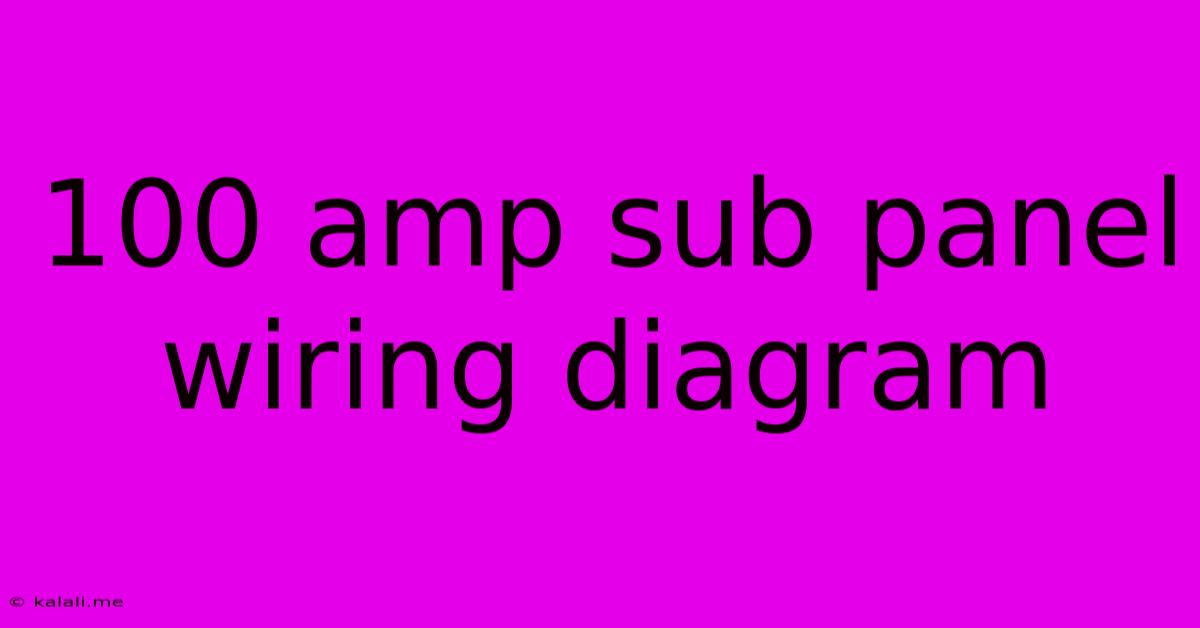100 Amp Sub Panel Wiring Diagram
Kalali
May 24, 2025 · 3 min read

Table of Contents
100 Amp Sub Panel Wiring Diagram: A Comprehensive Guide
This article provides a comprehensive guide to understanding and interpreting a 100-amp sub panel wiring diagram. We'll cover the essential components, safety precautions, and step-by-step instructions to ensure a safe and effective installation. Understanding these diagrams is crucial for anyone undertaking electrical work, especially concerning sub panels, which require a higher level of expertise than standard home wiring. Improper wiring can lead to serious hazards including electrical fires and shocks. Therefore, it's vital to prioritize safety and, if uncertain, consult a qualified electrician.
Understanding the Components of a 100 Amp Sub Panel Wiring Diagram
A typical 100-amp sub panel wiring diagram will illustrate the connection points between the main electrical panel and the sub panel, including:
- Main Breaker Panel: The source of power for your entire electrical system.
- Main Electrical Service: The incoming power lines from the utility company. This is typically 240 volts.
- Sub Panel: The secondary panel distributing power to a specific area of your home or building.
- Feed Wires: The conductors carrying power from the main panel to the sub panel. For a 100-amp sub panel, these are typically thicker gauge wires to handle the higher amperage. Common wire types include THHN, THWN, and XHHW.
- Ground Wire: An essential safety component that provides a path for fault currents to ground, preventing electric shock.
- Neutral Wire: Carries the return current back to the main panel.
- Hot Wires: Carry the electrical current from the main panel to the sub panel. Typically two hot wires are used for 240-volt circuits.
- Circuit Breakers: Individual switches in the sub panel that protect individual circuits from overloads and short circuits.
- Bus Bars: Metal bars inside the panel where wires are connected.
Safety Precautions: Always Prioritize Safety First!
Before starting any electrical work, it is imperative to follow these safety precautions:
- Turn off the power: Always disconnect the power to both the main panel and the sub panel before beginning any wiring work.
- Use appropriate safety equipment: Wear safety glasses, insulated gloves, and non-conductive footwear.
- Inspect the wiring: Check the wires for any damage before connecting them.
- Consult a professional: If you're unsure about any aspect of the process, consult a qualified electrician. This is crucial for high-amperage systems like a 100-amp sub panel.
- Understand local codes: Ensure your installation complies with all local building codes and regulations.
Interpreting the Wiring Diagram: A Step-by-Step Approach
While specific diagrams will vary, most will follow a similar format. They will use symbols and lines to represent the various components and their interconnections. Here's a general approach:
- Identify the main panel and sub panel: Locate these on the diagram.
- Trace the feed wires: Follow the lines representing the hot, neutral, and ground wires from the main panel to the sub panel. Pay close attention to the wire gauges and types indicated.
- Identify the circuit breakers: Locate the circuit breakers in the sub panel and note their amperage ratings.
- Understand the grounding system: Ensure the ground wire is properly connected to both the main panel and the sub panel. This is crucial for safety.
- Check for branch circuits: Observe how individual circuits are connected to the sub panel.
Common Issues and Troubleshooting
- Incorrect Wire Gauge: Using wires with insufficient amperage capacity can lead to overheating and potential fire hazards.
- Loose Connections: Loose connections can cause overheating, arcing, and potential electrical fires.
- Grounding Problems: Improper grounding can create shock hazards.
Remember: This article provides general information. Specific wiring diagrams for 100-amp sub panels will vary depending on the manufacturer and the specific electrical setup. Always refer to the manufacturer's instructions and consult with a licensed electrician if you have any doubts or uncertainties. Improper wiring can result in serious injury or property damage. Safety should always be your top priority.
Latest Posts
Latest Posts
-
How Long Is Dough Good For In The Fridge
May 24, 2025
-
Is Working Away A Good Phrase
May 24, 2025
-
Hamilton Beach Rice Maker Weird Taste
May 24, 2025
-
Logrotate Failed Sqlnet Log Failed Permission Denied Selinux Oracle Logs
May 24, 2025
-
Should There Be A Space After Footnotes
May 24, 2025
Related Post
Thank you for visiting our website which covers about 100 Amp Sub Panel Wiring Diagram . We hope the information provided has been useful to you. Feel free to contact us if you have any questions or need further assistance. See you next time and don't miss to bookmark.